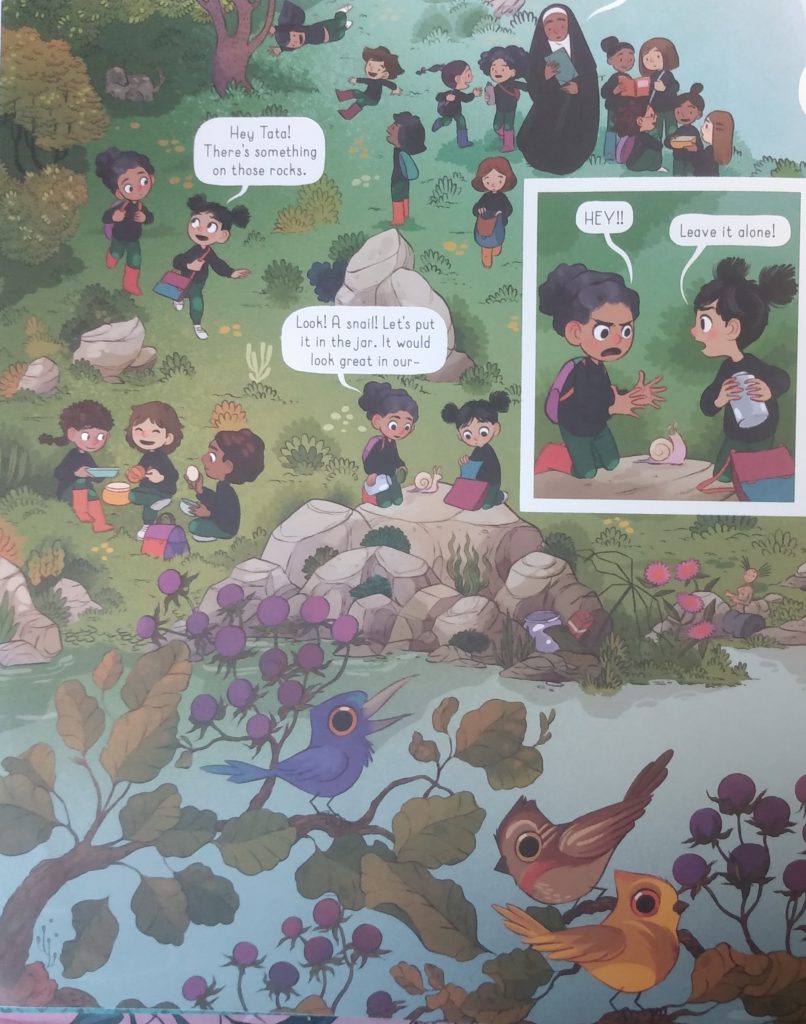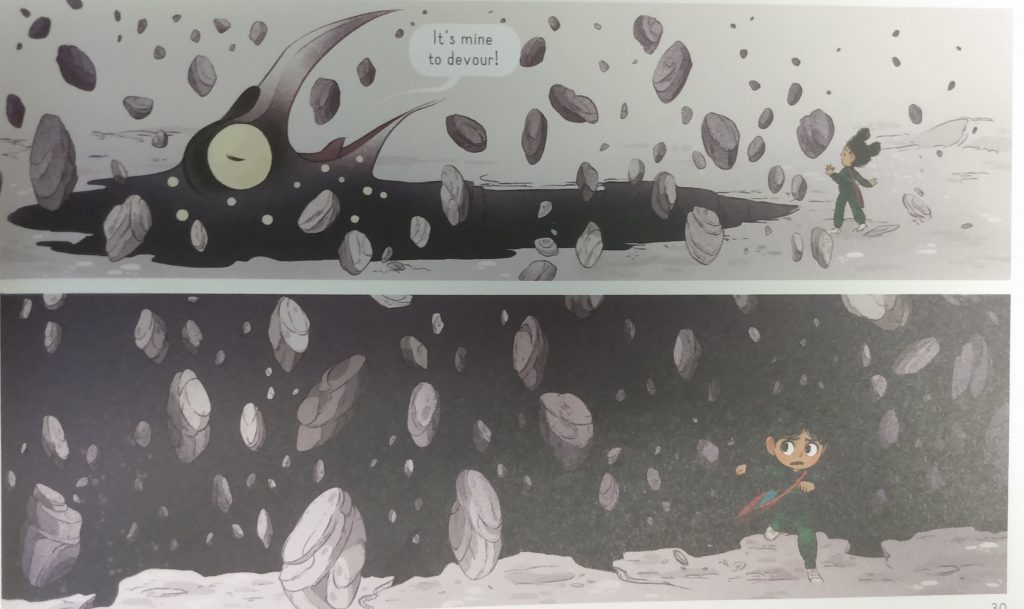“This place isn’t yours to understand. It’s mine to devour!” — Livion, Hicotea: A Nightlights Stories, n. pag.
| Creator(s) | Lorena Alvarez (author) |
| Publisher | NobBrow |
| Publication Date | 2019 |
| Genre | Fantasy, Fiction |
| Environmental Themes and Issues | Habitat Destruction, Pollution, Animal Abuse, Animals in Danger, Anthropomorphism |
| Protagonist’s Identity | Sandy: Hispanic/Latinx girl |
| Protagonist’s Level of Environmental Agency | Level 5: High Environmental Agency and Activism |
| Target Audience | Children |
| Settings | Bogotá, Colombia |

Environmental Themes
In Hicotea: A Nightlights Story, young protagonist Sandy’s class embarks on a field trip to the local wetlands. The comic begins in the science classroom of Sandy’s Catholic school as the students prepare for the trip. While Sandy and her friend Tata discuss what they plan to do on the field trip, another student dissects a frog as other children watch in horror. After slicing open the frog’s stomach, the student callously discards the dead animal in a trash can without dissecting it further. This opening scene introduces the comic’s central concern: the cruel exploitation of the environment. At the wetlands, the children explore a seemingly serene lake, though evidence of pollution appear along the shore. Tata captures a snail in a jar to submit to the teacher as her science project. Sandy tries to convince her to free the animal, pointing out that Tata doesn’t know how to care for it, but Tata refuses. Furious, Sandy storms away from the class and ventures deeper into the wetlands. She kicks a turtle shell and immediately feels regret, peering into the shell to see if the turtle is injured. Instead of seeing the turtle, however, she is magically transported to an alternate world inside the shell.

There, she discovers an elaborate museum filled with artwork and books. Sandy encounters Hicotea, an anthropomorphic turtle who lives inside and collects oddities. The turtle shows Sandy a blank painting on the wall that used to lead to the wetlands. Hicotea explains, “There’s something out there that won’t let me through. Every day I used to go out and explore the wetland. As I went further, it got bigger and there were more and more things to see… it was wonderful. But then something appeared… it wanted the wetland all for itself! I couldn’t fight its greed” (Alvarez n. pag.). Determined to help Hicotea, Sandy steps into the painting and finds herself in another alternate world: a white, barren landscape that used to contain the wetlands.

In the desolate wetlands, Sandy meets Den, a frog, who takes her to the last refuge of the wetland animals. The land dried out, Den informs her, after Hicotea encountered a frightening creature and locked herself away in her shell. Sandy falls asleep and wakes to discover a black bird has stolen her notebook. “This place is not yours to understand,” Livion, the bird, tells her, adding, “It’s mine to devour!” (Alvarez, n. pag.). The remaining wetlands crumbles away as Livion morphs into a flock of black crows and then turns into a giant crow, and Sandy finds herself transported back to Hicotea’s home, now ruined and empty. The crow cruelly tells her, “Your curiosity will only make you smaller and smaller… soon you’ll realize your insignificance and that you’ll never be able to understand the universe. In the end–the darkness will engulf you and your world” (Alvarez, n. pag.). However, Sandy rejects this message and magically transforms a marble into flowers that surround Livion, banishing him and restoring the wetlands. Hicotea returns to the wetlands, and Sandy travels back to her own world. Tata tells her that she freed the snail, and the comic concludes with Sandy finding Den in her garden and releasing him back in the now-vibrant wetlands.

While Brigid Alverson suggests that the crow could serve as a metaphor for self-doubt or depression, the bird could also represent the capitalistic logics that contribute to the pollution in the wetlands. Filled with greed, the crow only wants to devour and exploit the wetlands for its own gain, rather than explore the environment as Hicotea and Sandy do. By triumphing over the bird and treating Den and the snail with kindness, Sandy models a more harmonious relationship with nature. Additionally, the book highlights the ways that schools can encourage children to treat nature cruelly, both through the botched frog dissection and through Tata’s determination to capture the snail for her science project.
Additional Resources
Alverson, Brigid. “Hicotea.” The Comics Journal, 20 August 2019, http://www.tcj.com/reviews/hicotea/.



